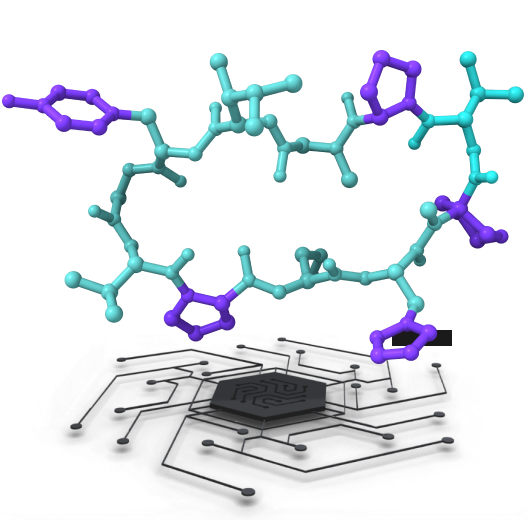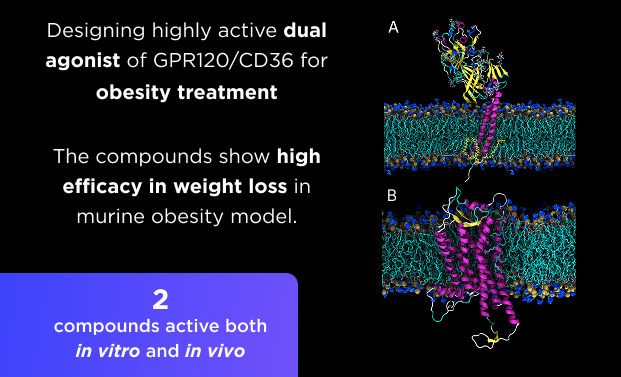AI-Navigated Drug Discovery
Our multiplatform ecosystem empowers pharma and biotech to accelerate small-molecule and peptide drug discovery through data-driven strategies, predictive modeling, and seamless integration of experimental insights.
Receptor.AI Platform Architecture
Unified 4-level architecture for modality-specific R&D strategy planning and execution:
- Level 1: R&D Strategy and Control
The Agentic AI selects validated R&D strategies, generates project plans, decision criteria, and continuously adapts them in real time under expert oversight.
- Level 2: Drug Discovery Workflows
End-to-end target-specific workflows are assembled according to the chosen strategy, project domain, data insights, and established constraints.
- Level 3: AI Model Stack
Dozens of rigorously benchmarked predictive and generative AI models are key workflow elements.
- Level 4: Data Engine
Public data collection with in-house result integration, followed by feature engineering to enable AI models’ active learning.

LEVEL 01
R&D Strategy and Control

Agentic AI creates the R&D project plan based on validated drug discovery strategies, monitors its execution across all platform levels, and adapts it under expert oversight.
- Strategy selection: Agentic AI chooses the drug discovery strategy tailored to the scientific and clinical profile constraints.
- R&D plan design: Relying on the strategy, the system creates the project plan and assembles end-to-end drug discovery workflows for each iteration.
- Risk Assessment: The plan is analysed by domain experts who reveal and control all potential risks connected to the project.
- Strategic adjustment: The system iteratively revises the R&D plan based on intermediate experimental results, expert insights, and resource dynamics.
01
LEVEL 02
Drug Discovery Workflows

End-to-end drug discovery workflows tailored to the therapeutic modality and target class are selected and configured according to the R&D plan.
- Supported modalities: Small molecules, linear and cyclic peptides, covalent inhibitors, and various proximity-inducing agents.
- Target-specific protocols: Tailored workflows for GPCRs, kinases, ion channels, enzymes, and targets involved in PPIs.
- Dry + Wet lab integration: We align computational and experimental parts of the workflow by accounting for the target biology and mechanism of action.
- Experimental integration: Each workflow has an embedded active learning strategy that guides experimental data generation.
02
LEVEL 03
AI Model Stack

A suite of advanced predictive and generative AI models designed to power core drug discovery tasks and enable efficient, data-driven optimization across the pipeline:
- ArtiDock: A high-throughput AI-powered docking engine for both small molecules and peptides, trained on the world’s largest augmented dataset.
- DeepTAG: A next-generation model for predicting protein-protein interaction interfaces without requiring structural templates — a major step beyond traditional tools like AlphaFold.
- ADMET: An industry-leading ADMET prediction engine covering 80+ endpoints, incorporating consensus scoring that accounts for inter-endpoint correlations and mechanistic dependencies for superior decision-making.
- OffTaRGet: A comprehensive selectivity profiling tool that combines ligand-based and structure-based prediction to assess off-target risk across closely related and mechanistically distinct targets.
03
LEVEL 04
Data Engine

A secure data management environment for collecting, engineering, and analyzing project-specific data, enabling fine-tuning of our AI models.
- Public data integration: LLM-powered knowledge graph extracts and systematizes all publicly available information as the project starts.
- Feature engineering: Revealing hidden structure-property relationships through the analysis of both natural and artificially generated compound descriptors
- Data-driven project guidance: Uncovering hidden correlations and uncertainties in the initial data to steer the subsequent experimental rounds.
- Data augmentation: AI-based data generation that enriches sparse experimental datasets to support AI models' fine-tuning.
04
Modality-specific Platforms
Receptor.AI operates across three modality-specific platforms: Small Molecules, Peptides, and Proximity Inducers. Each platform is a set of modality-specific workflows and AI models orchestrated by tailored Agentic AI. This modular structure ensures focused alignment for distinct modality requirements, providing end-to-end drug candidate design capabilities within each platform.
Small Molecules Platform
Target, indication, and MoA-specific design of small molecules using validated AI-based and data-driven workflows.
- Dedicated AI workflows for different target classes: kinases, GPCRs, ion channels, enzymes, etc.
- Identification and targeting of allosteric, hidden, transient, and cryptic pockets.
- Automated SAR analysis with a hybrid intelligence approach
- Selectivity optimization against highly similar isoforms and mutants.
- Prediction and optimization of the largest set of ADMET endpoints in the market.
Peptide Platform
AI-guided de novo design and optimization of linear and cyclic peptides against challenging targets, including “undruggable” protein-protein interactions:
- Unlimited diversity is only constrained by synthetic capabilities.
- Any non-natural amino acids, non-peptide building blocks, and linkage chemistry.
- Seamless integration with phage and RNA display techniques.
- Optimization of peptide activity, permeability, and oral availability.
- Peptide-to-small-molecule workflow to transform peptide binders to drug-like molecules with superior ADMET properties.
Proximity Inducers Platform
Transforming structurally unresolved native and induced PPIs into druggable targets with ternary complexes assembly:
- Designing PPI disruptors and various proximity engagers, such as degraders and molecular glues.
- Predicting protein-protein interfaces without known structures and homology templates using proprietary AI technologies.
- Targeting both natural and induced protein-protein interfaces.
- Handling large soluble and membrane supramolecular assemblies of any complexity.
- Developing diverse modalities such as small molecules, peptides, or drug conjugates.
Co-development Programs
validation




.png)




.png)

